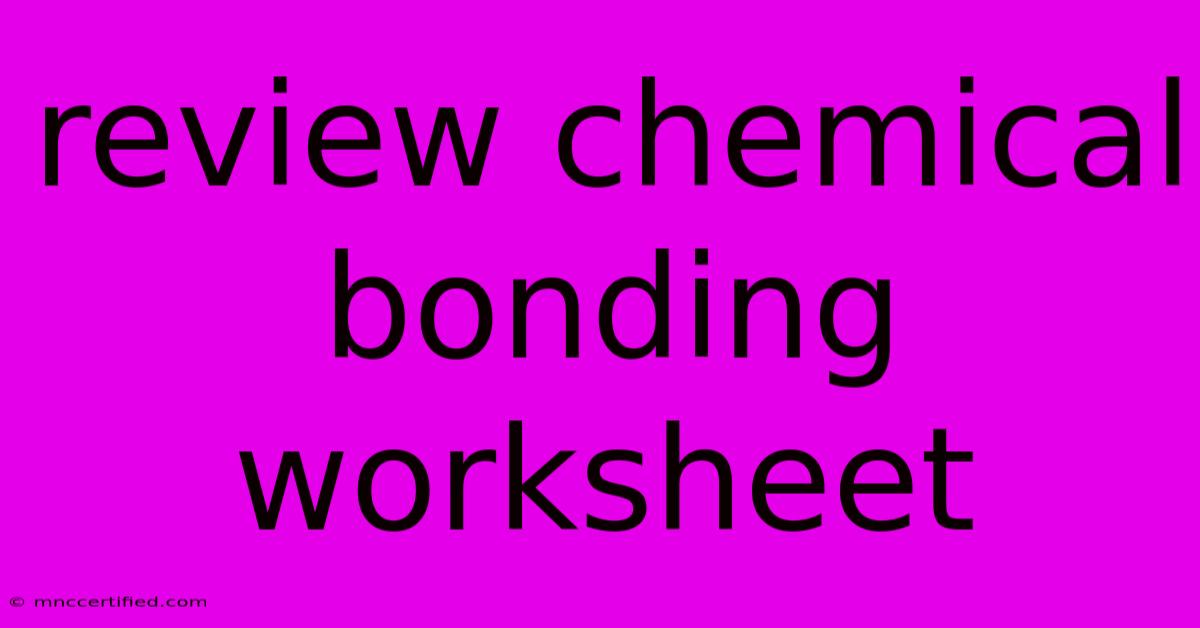Review Chemical Bonding Worksheet

Table of Contents
Review Chemical Bonding Worksheet: A Comprehensive Guide
This article serves as a comprehensive guide to understanding and conquering chemical bonding worksheets. We'll explore various types of chemical bonds, delve into the intricacies of Lewis structures, and provide strategies for tackling different question types. By the end, you'll be equipped to confidently approach any chemical bonding worksheet.
Understanding Chemical Bonds: The Foundation
Chemical bonding is the heart of chemistry, explaining how atoms interact to form molecules and compounds. The fundamental driving force behind bonding is the attainment of a stable electron configuration, often resembling that of a noble gas. There are several major types of chemical bonds:
1. Ionic Bonds: The Electron Transfer
Ionic bonds are formed through the transfer of electrons from a metal atom to a nonmetal atom. This transfer creates ions: positively charged cations (metal) and negatively charged anions (nonmetal). The electrostatic attraction between these oppositely charged ions constitutes the ionic bond. Key characteristics include high melting points, brittleness, and the ability to conduct electricity when dissolved in water or melted. Examples include NaCl (sodium chloride) and MgO (magnesium oxide).
2. Covalent Bonds: The Electron Sharing
Covalent bonds involve the sharing of electrons between two nonmetal atoms. Atoms share electrons to achieve a stable octet (eight electrons in their valence shell). The strength of a covalent bond depends on the number of shared electron pairs. Single bonds share one pair, double bonds share two pairs, and triple bonds share three pairs. Examples include H₂ (hydrogen gas) and CO₂ (carbon dioxide).
3. Metallic Bonds: A Sea of Electrons
Metallic bonds occur in metals. In this bonding type, valence electrons are delocalized, forming a "sea" of electrons surrounding positively charged metal ions. This allows for excellent electrical and thermal conductivity, malleability, and ductility. Examples include copper (Cu) and iron (Fe).
4. Polar Covalent Bonds: Unequal Sharing
Polar covalent bonds arise when electrons are shared unequally between two atoms. This unequal sharing results from a difference in electronegativity—the ability of an atom to attract electrons in a bond. The more electronegative atom carries a partial negative charge (δ-), while the less electronegative atom carries a partial positive charge (δ+). Water (H₂O) is a classic example.
Mastering Lewis Structures: Visualizing Bonds
Lewis structures are diagrams that represent the valence electrons of atoms and how they are shared or transferred in chemical bonds. Mastering Lewis structures is crucial for understanding chemical bonding. Key steps involve:
- Determine the total number of valence electrons: Add up the valence electrons from each atom in the molecule.
- Identify the central atom: Usually the least electronegative atom.
- Connect atoms with single bonds: Place a single bond (one electron pair) between the central atom and each surrounding atom.
- Complete octets: Distribute the remaining electrons to satisfy the octet rule for each atom (except hydrogen, which only needs two electrons).
- Use multiple bonds (double or triple) if necessary: If an atom lacks an octet, try forming double or triple bonds by sharing more electron pairs.
- Formal charge calculation: Helps determine the most likely Lewis structure, especially with resonance structures.
Tackling Different Worksheet Question Types
Chemical bonding worksheets can present various question types. Here are some common ones and strategies to tackle them:
- Drawing Lewis Structures: Practice drawing Lewis structures for a wide range of molecules and ions. Start with simple diatomic molecules and progressively move towards more complex structures.
- Identifying Bond Types: Determine whether a bond is ionic, covalent (polar or nonpolar), or metallic based on the electronegativity difference between the atoms involved.
- Predicting Molecular Geometry: Use VSEPR theory to predict the shapes of molecules based on their Lewis structures. This involves understanding electron domains and lone pairs.
- Explaining Properties: Relate the type of bonding to the physical and chemical properties of the substance (e.g., melting point, boiling point, conductivity).
Off-Page SEO Strategies for Enhanced Visibility
To improve the search engine ranking of this blog post, consider the following off-page SEO strategies:
- Guest Blogging: Contribute high-quality articles on relevant chemistry websites or blogs. Include a link back to this article.
- Social Media Promotion: Share this article across various platforms (e.g., Twitter, Facebook, LinkedIn) to reach a wider audience.
- Forum Participation: Engage in online chemistry forums and provide helpful answers. Include a link to this article when relevant.
- Backlink Building: Focus on earning high-quality backlinks from reputable chemistry websites.
By following these tips and consistently practicing, you will develop a thorough understanding of chemical bonding and confidently tackle any worksheet that comes your way. Remember, practice is key to mastery!

Thank you for visiting our website wich cover about Review Chemical Bonding Worksheet. We hope the information provided has been useful to you. Feel free to contact us if you have any questions or need further assistance. See you next time and dont miss to bookmark.
Featured Posts
-
Glastonbury Tickets Sold Out In 30 Minutes
Nov 17, 2024
-
England Fall Short South Africa Wins Again
Nov 17, 2024
-
Same Reaction Chris Mc Causlands Strictly Dance
Nov 17, 2024
-
Littlers Grand Slam Darts 2024 Show
Nov 17, 2024
-
Black Label Trading Company Cigars
Nov 17, 2024